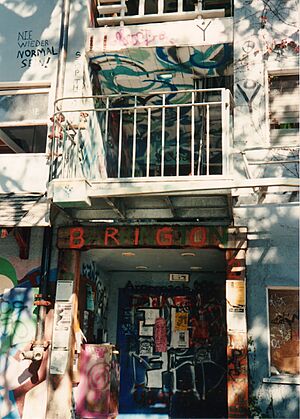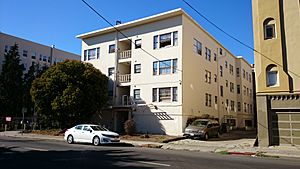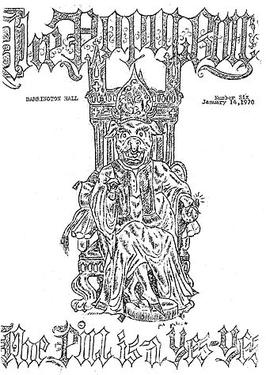Barrington Hall (Berkeley, California) facts for kids
Barrington Hall was a special kind of student home in Berkeley, California. It was part of the Berkeley Student Cooperative (BSC) system, which helps students find affordable places to live. Barrington Hall was open from 1935 to 1943 and again from 1950 to 1989. Today, it's still student housing, but it's run by a private company.
Contents
History of Barrington Hall
The first Barrington Hall was a house rented from a group called Sigma Nu in 1933. In 1935, the student cooperative bought a much bigger building at 2315 Dwight Way. This new building became the new Barrington Hall. It used to be the largest apartment building in Berkeley and could house 200 men when it first opened.
From 1943 to 1948, the building was used by the United States Navy. When the Navy left, they had made many improvements to the building. Barrington Hall, like all homes in the student cooperative, welcomed all students, no matter their background or beliefs.
A Place for Change
Barrington Hall was known for supporting social and political action. In 1960, students from Barrington Hall joined protests against a government committee called the House Committee on Un-American Activities.
By 1969, during the People's Park protests, Barrington Hall was a very well-known place in Berkeley. It was only two blocks from People's Park. Barrington became a place where people felt safe to be different and express themselves. It was a place where people could stay if they had nowhere else to go.
In the 1970s and 1980s, some students living there were very active in the anti-apartheid movement. This movement worked to end unfair racial separation in South Africa. Residents also offered food and shelter to people who were homeless. In 1984, students at Barrington voted to make the Hall an official safe place for refugees from El Salvador.
Challenges and Closure
Over the years, Barrington Hall became famous for its lively and sometimes wild atmosphere. Neighbors started to complain in the early 1960s. A court even said that Barrington Hall's reputation was "larger than life."
In 1989, after several tries, the student cooperative voted to close Barrington Hall. This decision was made because of problems linked to the Hall's very free-spirited environment. The students living there fought against the closure. They protested in court and even stayed in the building without permission, which is called squatting.
In March 1990, the squatting led to a big event that involved the police and residents. After this, 17 people were arrested. The students were allowed back in the building the next day, but the final eviction of all residents happened in September 1990.
Today, the building that was once Barrington Hall is still student housing, but it is run by a private company.
Music at Barrington Hall
Before 1984, Barrington Hall was a famous place for punk rock music. Many bands played there often.
In the early 1980s, a band called the Lemmings was the house band for some dinners. Their song "I'm on Sound" described what it was like to live at Barrington. The cover art for their album was even painted as a mural on the Hall's walls.
The band Primus got the idea for their song "Frizzle Fry" and their album Tales From the Punchbowl from parties at Barrington. Many famous punk bands played at Barrington in the 1980s, including Black Flag, Flipper, X, NOFX, Operation Ivy, and Dead Kennedys.
In 2002, the band Les Claypool's Frog Brigade released a song called "Barrington Hall" that was all about the place. It included lyrics like, "Does anyone here remember Barrington Hall? Does anybody here remember Barrington?"
After 1984, new rules meant that bands could only play with loud music at three parties each semester.
Murals and Graffiti
Much of the four-story building was covered with amazing murals and graffiti.
The tradition of painting murals started in the 1960s. Many early murals were painted by the students living there, like a big mural of the Beatles' Yellow Submarine. As time passed, the murals changed, with 1980s murals having more of a punk rock style.
Old murals were considered very important by the house rules. This meant that the artistic expressions from many different decades stayed on the walls. The walls of Barrington Hall became a living history of the counterculture movement in the U.S. during the late 20th century. One mural from the 1970s showed Sacco and Vanzetti. A well-known mural from the 1980s, painted in a bright, colorful style with Japanese anime features, even mentioned Disneyland. It was just inside the front entrance and said:
-
- "Welcome to Barrington, kids! Please keep your hands and arms inside the ride at all times."
Graffiti also became a tradition in the 1980s. It included everything from large, colorful spray paint designs to simple words written on the walls, like "Only seven more shopping days till Armageddon."
Insect Banquet
For many years, Barrington Hall held a yearly insect banquet. At this event, people would eat insects, which is called entomophagy. This unique banquet was often mentioned in a newspaper column by Herb Caen in the San Francisco Chronicle.
The Barrington Bull Newspaper
The Barrington Bull was a newspaper created and published by the students of Barrington Hall. It was printed from 1936 to 1989. For a short time in 1938, its name was changed to The Barbarrington. It was the very first publication of any kind from the student cooperative association.
In the 1950s, famous science fiction writers Terry Carr and Ron Ellik were editors of the Barrington Bull. In the 1960s, each issue started to have a special theme. Some themes from the 1970s included "The 'Onngh Yanngh' Bull," "The 'Wasted' Bull," and "The Hippie Ghetto' Bull."
Famous People Who Lived at Barrington
Many interesting people lived at Barrington Hall over the years, including:
- John C. Dvorak, a well-known writer and broadcast personality.
- Jewlia Eisenberg, who helped start the band Charming Hostess.
- Andreas Floer, a mathematician who invented something called Floer homology.
- Agustin Fuentes, a professor of anthropology at Princeton University.
- Micah Garen, a journalist and filmmaker.
- Brian Herbert, an author of many science fiction novels.
- Rodney Koeneke, a poet.
- Michael Lehmann, a film and television director.
- Giovanni Rossi Lomanitz, a physicist.
- Bob Pisani, a reporter for CNBC.
- Sam Quinones, a journalist and author.
- Karl Taube, a professor who studies ancient Mesoamerican writing and religion.
- Michael Tigar, a famous lawyer.
- Steve Wozniak, who helped create Apple.
- Betsy Wellings, a singer-songwriter.
- Nancy Skinner (California politician), a California politician.




